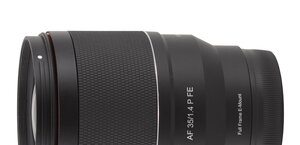Voigtlander Nokton 25 mm f/0.95
3. Build quality
The photo below shows the tested Nokton positioned between the Sigma 1.4/30 and the Olympus 12-60 mm. The comparison between the Voigtlander Nokton and the Sigma seems to be the most reliable here because those two give very similar angles of view on their respective sensors and they feature almost identical depth of field as well.
 |
Please Support UsIf you enjoy our reviews and articles, and you want us to continue our work please, support our website by donating through PayPal. The funds are going to be used for paying our editorial team, renting servers, and equipping our testing studio; only that way we will be able to continue providing you interesting content for free. |
- - - - - - - - - - - - - - - - - - - - - - - - - - - - - - - - - - - - - - - - - - - - - - - -
If you ever held any of Voigtlander lenses in your hand, you won’t be disappointed by the Nokton 0.95/25. Its build quality is really beyond reproach – we deal here with metal and glass, nothing more.
The lens starts with a short metal bayonet mount of the Micro 4/3 system. You can’t find any contacts there so the body won’t record any information about the focal length and the aperture value - because of that, we don’t have an access to the EXIF data. The rear element is 2.5 cm in diameter and it is positioned more or less on the same level as the mount when the focus is set at infinity. When we pass to the minimum focus the element hides inside the barrel by about 0.5 cm.
 |
On a black and metal barrel we find the depth of field scale first, with the markings for f/16, f/8 and f/4.0 aperture, and then, on the other side of it, the serial number of the lens and the “Lens made in Japan” inscription. Further on, we see a manual focus ring, 3 cm wide. The ribs and shallow finger grooves take most part of it. On the rest of the barrel you can find the distance scale expressed in meters and inches/feet. The ring’s work is perfect, being smooth and well-damped in the whole range. Running through the scale takes the turn of as many as 270 degrees. It allows you very precise settings.
Behind the manual focus ring starts a quite significant part of the barrel which extends a bit when we pass to infinity. On this part there is an aperture ring 7 mm wide. We can change the aperture every 0.5 EV stop using only the ring, it is not possible to change it from the level of the camera menu as it was the case of the Voigtlander SL II series devices, designed for full frame. The aperture ring is a joy to use and simply beyond reproach.
The front element of the lens, 43 mm in diameter, is surrounded by inscriptions, stating the name and the parameters of the lens and a non-rotating filter thread with a diameter of 52 mm.
The lens consists of 11 elements positioned in 8 groups. On the Cosina’s website you can actually read “8 Groups 11 Elements, using high reflection glass”. “Reflection” is something we would like to avoid in a lenticular lens, we presume they meant “refraction” – so high-refraction-index elements were supposedly used in the lens’s construction. The miniature optical construction scheme doesn’t indicate precisely what elements they mean, though. Inside the lens you can also find an aperture with ten diaphragm blades which can be closed down to f/16.
 |
The buyer will get both caps and a hood with its own fitting cap included in the box.
 |






